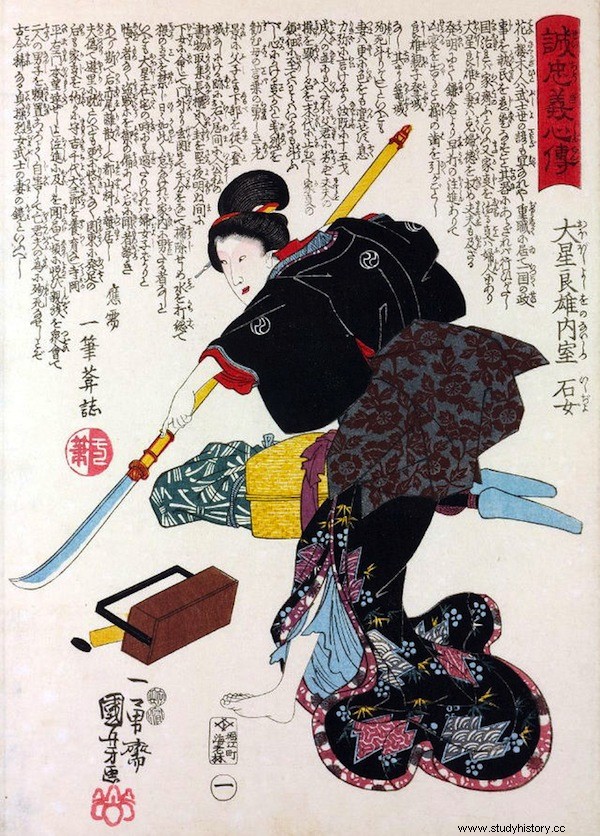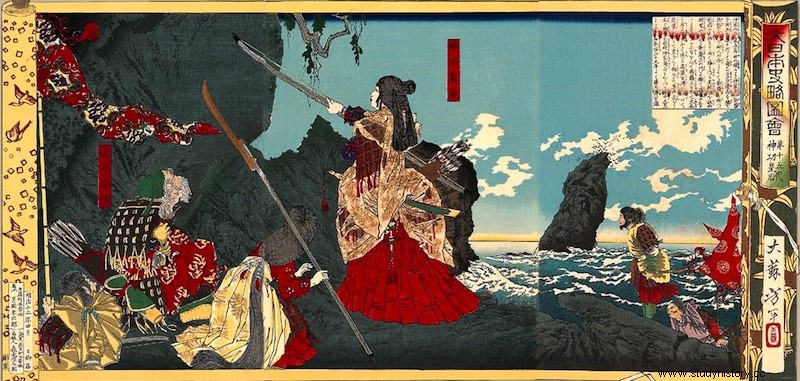The word “samurai ” is generally used to designate a wide variety of warriors from ancient Feudal Japan. Such was the strength of this sector of the population, that from the 10th century to the 12th century they held power. However, “samurai ” literally means “he who serves And for centuries, that's what they did. They were skilled warriors in the art of fighting, and many of them had daughters or sisters who were also trained in this art. Their function was to protect the home, honor and family in times of war, and for this they mainly used the naginata , a polearm containing a curved blade at one end. Some of these women went down in the annals of history for their deeds and strength. These figures were known as “Onna Bugeisha ” (samurai woman). Their number is few, but such were their exploits that many of them became legend.

Onna Bugeisha with naginata
Probably the most famous of this small group is the Okinaga Empress , known posthumously as the Empress Consort Jingū and commonly identified with Queen Himiko or Pimiko from Chinese chronicles. She was the wife of the Emperor Chūai and after her death in 209, she held the position of regent and leader until her son acceded to the throne in 269. Numerous are the legends surrounding this woman. Chinese chronicles describe her as a shamanic queen, engaged in witchcraft and bewitching people. Likewise, these texts relate the tributary relations that the kingdom of Cao Wei maintained with the kingdom of Himiko. According to the legend collected in the Kojiki and the Nihonshoki ., the gods spoke to Empress Okinaga to lead an army to invade the Western kingdom (identified as the Kingdom of Silla in southwestern Korea). Following the oracle's directions, she went to Kashihi Bay in Kiushu, untied her hair, and bathed in the sea water. Immediately, her hair parted into two equal parts. Then she tied it up into two buns, taking on the look of a warrior. After this fact, she addressed her ministers giving orders to gather a large army that she herself would lead by adopting the appearance of a man.
Once the army was gathered, the sovereign prepared for battle. Being pregnant and about to give birth, the sovereign took some stones and put them in the waist of her dress, in order to delay childbirth. No doubt the stone trick worked considering the campaign lasted three years, and the empress would not give birth until after it. In the first month of winter, the fleet sailed from the island of Tsushima, next to Kiushu, to the kingdom of Silla. Frightened by the arrival of such naval and arms power, the king of Silla decided to prepare a white flag and appear before the conquerors with his hands tied behind his back as a gesture of submission.

The Empress in Korea (1880 painting)
Historians reject this legend claiming that it is an invention to justify the interregnum period during her regency. However, Japanese sources do describe a sovereign closely linked to the goddess Amaterasu , who performed all the priestly functions and with great gifts for war. Although the name of Himiko or Pimiko does not appear in the Japanese sources, the correspondence in chronology and description of the same in the Chinese sources, seems to establish a clear parallelism between both figures. Also, its literal translation, “daughter of the sun ”, They clearly relate her to Amaterasu, of whose temple she would be her high priestess, elevating her to the category of deity.
The true identity of Himiko it remains a mystery. In 2009, Japanese scientists discovered what appeared to be her grave near Nara. However, their results were not conclusive. For now, we have to fantasize about one of the great samurai women. The woman who conquered Korea .
Collaboration Raquel Castañón de Okaerinasai
Sources:“The myths of Japan. Between history and legend ”- Carlos Rubio, “Religions of Japan ” – Yusa Michiko
